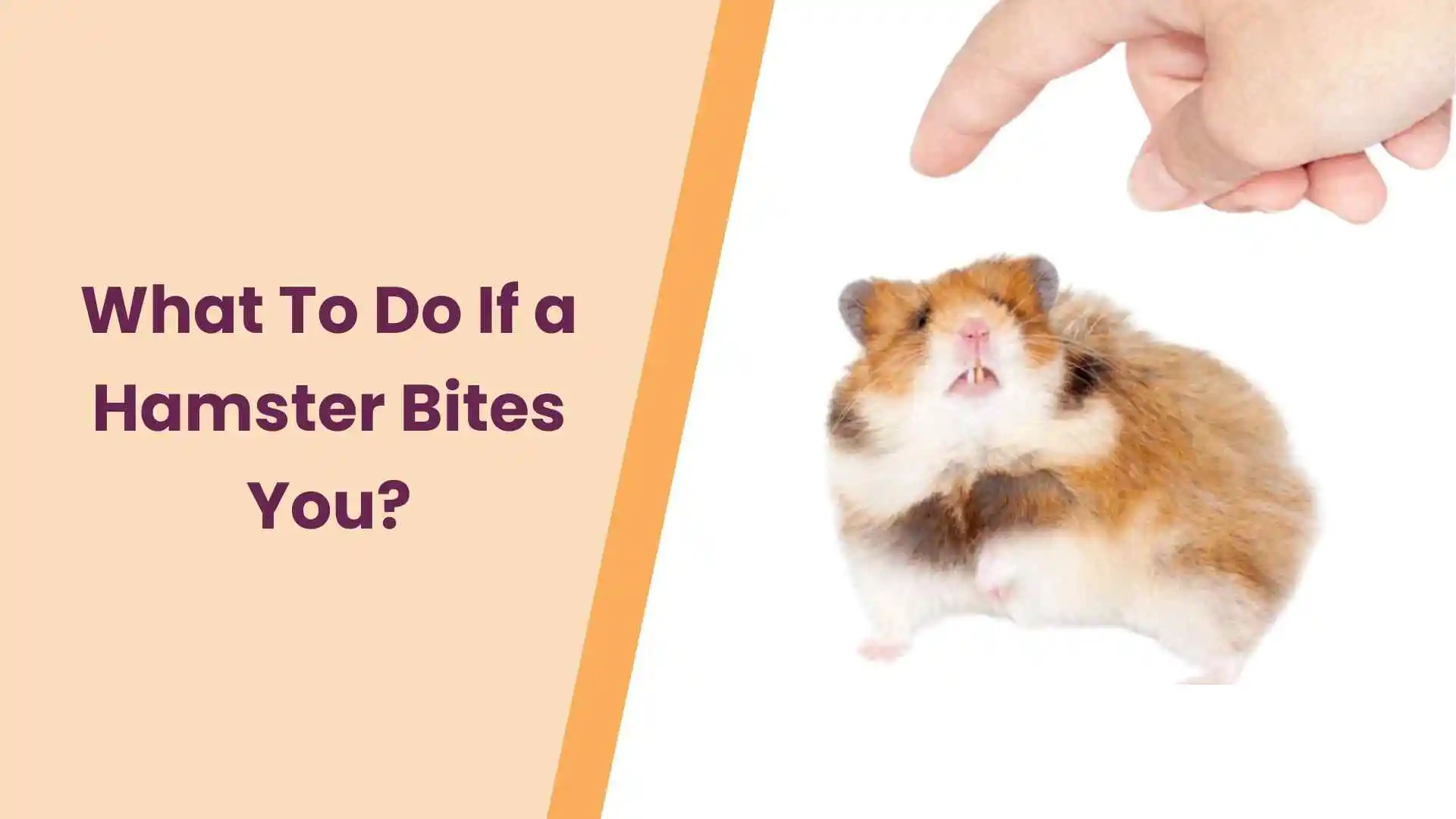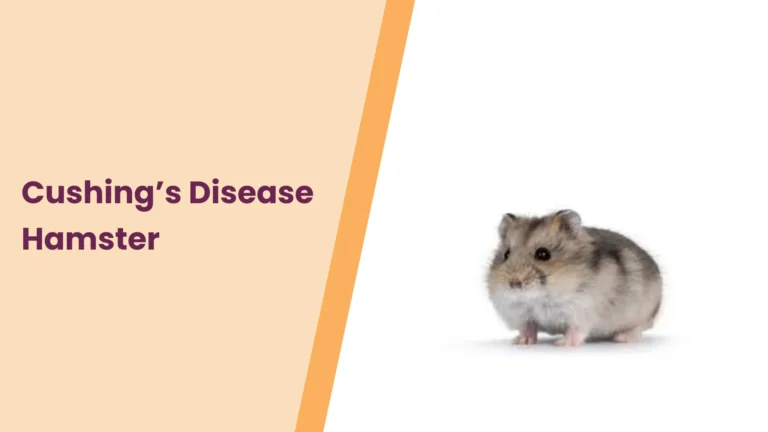What To Do If a Hamster Bites You? – An Ultimate Guide
Hamsters, those tiny balls of fur with endless curiosity, bring immeasurable joy to our lives. They’re the charming pocket pets that warm our hearts and fill our homes with their endearing antics. But as with any relationship, there are occasional bumps in the road. If you’ve ever felt the unexpected nip of a hamster’s tiny teeth, you’re not alone.
Hamster bites, though usually harmless, can catch any hamster owner off guard. Fear not, for this guide is here to help you navigate these small but sometimes surprising challenges in your journey as a hamster caregiver.
Understanding Hamster Behavior
Hamsters are endearing creatures, but they come with their own set of behaviors and instincts that may sometimes leave you puzzled. To be the best hamster parent you can be, it’s essential to delve into the intricacies of their behavior. This not only helps you appreciate their unique personalities but also equips you to handle situations where a hamster bite may occur.

Hamster Nature: First and foremost, it’s vital to grasp the essence of hamster nature. Hamsters are small, territorial animals, and they are often wary of new and unfamiliar situations. They have a natural instinct to protect their space, which can sometimes manifest as a bite if they feel threatened or cornered. Knowing this can help you approach your hamster with the care and respect they deserve.
Causes of Hamster Bites: Understanding the triggers for hamster bites is crucial. These can include fear, stress, or territorial aggression. Hamsters may bite when they are startled, handled roughly, or if they feel they have no escape route. They’re not being mean; they’re merely reacting to their instincts. Knowing the reasons behind their bites can help you avoid such situations.
Approach with Patience: Hamsters are sensitive animals that may take some time to warm up to you. Patience is key when building trust with your furry friend. Always approach your hamster calmly and avoid sudden movements. Gradually introduce your scent by placing your hand near their cage, allowing them to become accustomed to your presence.
In this section, we’ve begun to uncover the layers of hamster behavior, highlighting their natural instincts, the causes of bites, and the importance of patience when interacting with your hamster. By understanding your pet’s behavior, you’ll be better prepared to prevent and handle hamster bites, strengthening the bond between you and your tiny companion.
Immediate Response – Staying Calm When Hamsters Bite
Hamster bites can be startling, to say the least. The sudden nip of those tiny teeth can catch anyone off guard. When it happens, the key is to remain calm. Panicking or reacting with fear can escalate the situation, making it more stressful for both you and your hamster.
Stay Calm and Still: If your hamster bites you unexpectedly, take a deep breath, and avoid sudden movements. Jerking away in fear may startle your hamster further, leading to a more significant reaction.
Gently Remove Your Hand: Slowly and gently withdraw your hand from your hamster’s vicinity. Avoid yanking your hand back, as this may cause further harm to both you and your pet. Remember, your hamster’s bite is a reaction to a perceived threat, and your goal is to minimize harm.
Do Not Punish Your Hamster: Resist the urge to scold or punish your hamster. Remember that they’re not biting out of malice but because of instinct or fear. Punishing them will only exacerbate their stress and fear, making future bites more likely.
By keeping a level head and responding calmly, you minimize the chances of further bites and ensure a more positive experience for both you and your hamster. Next, we’ll explore how to assess the bite and take appropriate action to care for it, ensuring a smooth recovery.
Assessing the Bite – From Nips to Wounds: Understanding Hamster Bites
Hamster bites come in varying degrees, from minor nips to more serious wounds. It’s essential to assess the bite to determine the appropriate course of action. Understanding the severity of the bite allows you to provide the right care and prevent complications.
Minor Nips: Some hamster bites may leave little more than a red mark or a minor scratch. In these cases, clean the area gently with soap and water to prevent infection. Apply an antiseptic to help prevent any bacterial contamination. Minor bites often heal quickly and don’t typically require further medical attention.
Deep Bites: If the bite breaks the skin or causes bleeding, it’s considered a deeper bite. In such cases, cleaning the wound is crucial. Use warm water and mild soap to cleanse the area thoroughly. Apply an antiseptic, and consider covering the wound with a bandage to protect it. Keep a close eye on the wound for any signs of infection, such as redness, swelling, or discharge. If the wound becomes infected, or if you’re unsure about its severity, seek medical attention promptly.
Preventing Infection: Regardless of the severity of the bite, keeping the wound clean is vital to prevent infection. Infection can lead to more significant issues, so maintain good hygiene when caring for the wound. If you notice any signs of infection, consult a healthcare professional to address the issue promptly.
By assessing the bite’s severity and taking appropriate measures, you can ensure a safe and healthy recovery. While minor hamster bites can be managed at home with simple first-aid care, deeper bites require more attention and potential medical intervention to prevent complications. Understanding the nuances of hamster bites is the key to handling them effectively.
Treating a Minor Hamster Bite – Simple Care for Superficial Nips
Minor hamster bites are relatively common and, fortunately, tend to be harmless. These small nips, while surprising, usually don’t require extensive medical attention. Here’s how to care for them effectively:
Clean the Wound: Begin by gently washing the affected area with mild soap and lukewarm water. Pat the area dry with a clean, soft cloth. This step is crucial to prevent any potential infection.
Apply Antiseptic: After cleaning, apply an over-the-counter antiseptic or hydrogen peroxide to the wound. This helps to further disinfect the area and reduce the risk of infection.
Cover with a Bandage (Optional): Depending on the location of the bite and to prevent further irritation, you can choose to cover the wound with a clean bandage. This is especially useful if the bite is in a spot that’s prone to friction or if you tend to scratch unconsciously.
Monitor the Bite: Keep a close eye on the bite as it heals. Minor bites usually resolve on their own within a few days. If you notice any signs of infection, such as increased redness, swelling, or discharge, or if the wound doesn’t seem to be improving, consult a healthcare professional.
Maintain Good Hygiene: During the healing process, continue to practice good hygiene around the wound. This includes keeping the area clean and avoiding unnecessary contact that could introduce contaminants.
While minor hamster bites can be a bit startling, they are typically easy to manage with simple first-aid care. Following these steps can help ensure a speedy recovery and prevent complications. Remember, even minor bites can become problematic if they become infected, so cleanliness is key.
Preventing Future Bites – Building Trust and a Harmonious Relationship
Hamster bites are often a reaction to fear or stress, and as a responsible hamster owner, you can take proactive steps to prevent future incidents. Here’s how to build trust and reduce the likelihood of hamster bites:
Gentle Handling: Approach your hamster with gentleness and patience. Avoid sudden movements, loud noises, or intrusive gestures that can startle or stress your furry friend. Over time, your hamster will become more comfortable with your presence.
Frequent Socialization: Regular interaction with your hamster is key to building trust. Spend time near their enclosure, talk to them softly, and offer treats. Gradually extend this to handling your hamster for short periods, allowing them to become accustomed to your touch.
Positive Reinforcement: Reward your hamster’s good behavior with treats and gentle praise. This positive reinforcement helps your pet associate you with positive experiences, making them more receptive to interaction.
Recognize Their Signs: Learn to read your hamster’s body language. If your hamster displays signs of fear or discomfort, such as raised fur, backing away, or hissing noises, give them space and time to calm down. Avoid pushing interactions when they’re not in the mood.
Safe Environment: Ensure your hamster’s habitat is comfortable and secure. Provide hiding spots and enrichment to reduce stress and encourage natural behaviors.
Consistency: Be consistent in your care routine. Hamsters thrive on predictability. Regular feeding and cleaning schedules help minimize stress.
No Sudden Wake-Ups: Hamsters are crepuscular, meaning they’re most active during dawn and dusk. Avoid waking your hamster during the day, as they may be grumpy and more likely to bite when disturbed from sleep.
By following these tips, you can build a trusting and harmonious relationship with your hamster. Remember that patience and understanding go a long way in preventing future bites. Your hamster will reward your efforts with their charming and endearing personality, making the bond between you and your pet stronger every day.
When to Seek Professional Help – Ensuring Your Hamster’s Well-Being
While most hamster bites are minor and manageable, there are situations where professional help is necessary. Understanding when to seek expert assistance is essential for ensuring your hamster’s well-being.
Deep Bites and Severe Bleeding: If the hamster bite breaks the skin and results in significant bleeding that doesn’t stop after applying gentle pressure, it’s a clear indication to consult a healthcare professional. Deep bites may require stitches, antibiotics, or other medical intervention to prevent infection and promote proper healing.
Signs of Infection: Keep a vigilant eye on the bite wound. If you notice signs of infection, such as increasing redness, swelling, pus, or a foul odor, it’s crucial to seek immediate medical attention. Infections can escalate rapidly and pose a significant risk to your hamster’s health.
Allergic Reactions: In some cases, a hamster bite may trigger an allergic reaction in the form of hives, itching, or swelling. If you observe any unusual or severe allergic responses, it’s best to contact a healthcare professional or emergency services promptly.
Persistent Pain or Discomfort: If you experience persistent pain, numbness, or discomfort at the bite site, this could indicate a more severe issue, such as nerve damage. Seek medical evaluation to ensure there are no underlying problems.
Unsure About the Severity: If you’re uncertain about the severity of the bite, or if you’re worried about potential complications, don’t hesitate to consult a veterinarian who specializes in exotic pets or a healthcare professional. They can provide guidance and assess the situation.
It’s important to remember that your hamster’s well-being is a top priority. Don’t hesitate to seek professional help when you’re in doubt about the bite’s severity or if you notice any concerning symptoms. Timely intervention can prevent complications and ensure your hamster’s continued good health.
Conclusion
In the world of hamster ownership, bites can be an unexpected twist in our delightful journey with these charming pocket pets. But here’s the reassuring truth: hamster bites are manageable, and they don’t diminish the bond we share with our furry companions.
By understanding hamster behavior, responding calmly to bites, and assessing them properly, we equip ourselves to care for our hamsters’ well-being and strengthen our relationship with them. Preventing future bites is all about building trust, patience, and creating a harmonious environment. Remember, your hamster is a unique individual with distinct needs and quirks, and the more you invest in their happiness, the more rewarding your journey together becomes. Seeking professional help when necessary is an act of responsible care, ensuring your hamster’s health is safeguarded.
So, if you’ve ever experienced a hamster bite or are preparing for the possibility, remember that with knowledge, care, and compassion, you’ll continue to enjoy the joys of hamster ownership. Hamsters enrich our lives with their endearing personalities, and with the right approach, you can ensure their safety and happiness while savoring the delightful moments they bring to your world.
“Our hamster care community thrives on shared experiences, insights, and the love we have for our tiny companions. We encourage you to join the conversation by leaving your thoughts, questions, or personal stories in the comments section below.
Your valuable input not only enriches our content but also offers support to fellow hamster enthusiasts. If you’ve found this information helpful, consider sharing it with your friends and fellow pet lovers on social media, forums, or any platform where you think it could make a difference. Hamster care is a collective journey, and your contributions help us create a network of caring, informed hamster parents.
Thank you for being a part of our hamster care community. Your engagement and shared knowledge are what make this a warm and vibrant space for all hamster enthusiasts. We can’t wait to hear from you and learn from your unique hamster tales!” – Hamsterpit







